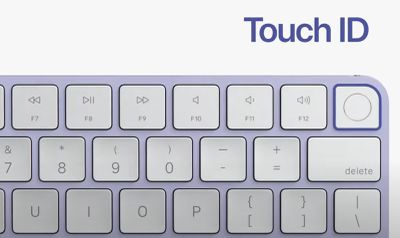Apple today updated its Platform Security Guide with in-depth security information about the new Magic Keyboard with Touch ID, the ability to unlock an iPhone with an Apple Watch while wearing a mask, and more.

The updated guide reveals a few interesting tidbits about the Magic Keyboard with Touch ID, including that it is compatible with the built-in Touch ID sensor on recent MacBook Pro and MacBook Air models:
Magic Keyboard with Touch ID and built-in Touch ID sensors are compatible. If a finger that was enrolled on a built-in Mac Touch ID sensor is presented on a Magic Keyboard with Touch ID, the Secure Enclave in the Mac successfully processes the match—and vice versa.
This compatibility means that, from a technical standpoint, there is nothing stopping Apple from selling the Magic Keyboard with Touch ID on a standalone basis. As we previously reported, the new Magic Keyboard is fully compatible with all M1 Macs, but Apple is currently only offering the keyboard with the new iMac unveiled last month.
Apple has made some previously iMac-exclusive accessories available to purchase separately at a later date in the past. When the iMac Pro launched in December 2017, for example, Space Gray versions of the Magic Keyboard, Magic Mouse, and Magic Trackpad were only available with the iMac Pro, but became available separately in March 2018.
The updated guide also reveals that the Magic Keyboard with Touch ID can be securely paired with only one Mac at a time, but a Mac can maintain secure pairings with up to five
different Magic Keyboard with Touch ID keyboards.
To enroll a new fingerprint, the user must physically confirm their intent to use a Magic Keyboard with Touch ID with the Mac, according to Apple. Physical intent is confirmed by pressing twice on the Mac power button when indicated by the user interface, or by successfully matching a fingerprint that had previously been enrolled with the Mac.
As for unlocking an iPhone with an Apple Watch on iOS 14.5 and watchOS 7.4 or later, the following criteria must be met, according to Apple:
• iPhone must have been unlocked using another method at least once after the
associated Apple Watch was placed on wrist and unlocked.
• Sensors must be able to detect that the nose and mouth are covered.
• Distance measured must be 2–3 meters or less
• Apple Watch must not be in bedtime mode.
• Apple Watch or iPhone must have been unlocked recently, or Apple Watch must have
experienced physical motion indicating that the wearer is active (for example, not
asleep).
• iPhone must have been unlocked at least once in the past 6.5 hours.
• iPhone must be in a state where Face ID is allowed to perform a device unlock.
The updated Platform Security Guide is available on Apple's website, with a document revision history included on page 214.






















